
 |
Learning from community service: Engaging Australia Tanzania Young Ambassadors with sustainability
Karen Murcia
Edith Cowan University
Yvonne Haigh and Lindy Norris
Murdoch University
Many secondary schools, both in Australia and internationally include community service initiatives as an integral component of students' school experience. This practise is widely based on the assumption that young people benefit from helping others outside of the economies of exchange. Service projects linked intentionally to the regular curriculum can provide opportunities and even demands for students to make learning connections between the abstract theories of the classroom and their everyday world outside. The Australian Tanzanian Young Ambassadors (ATYA) is one such program. The ethnographic study of this program by a participant researcher is described and explored in this paper. This research focussed on the opportunities and demands for students' development of scientific literacy and an understanding of sustainability as they participated in an international community service tour and Bilateral Youth Forum in Tanzania. Insights from the research experience lead to the development of a framework for linking community service projects to the science curriculum, which is intended to support community service coordinators and teachers working with youth.
Initiatives within the ATYA program assisted students in understanding that humanity's increasing science knowledge base and access to a diverse range of technologies had, for industrialised nations, improved life expectancy, the quality of life and reduced the need for physical labour. Industries and homes in the industrialised countries were powered by fossil fuels, health care has improved and many infectious diseases effectively controlled. Applications of science have revolutionised transport and allowed world-wide communication. However, upwardly spiralling world population and industrialisation has come at a high cost to natural environments. The current and projected rate of consumption of natural resources by industrialised nations is considered unsustainable by many international organisations such as the United Nations (1992) and the World's Scientific Academies (2000). In addition na•ve use of technology has arguably contributed to global pressures such as land degradation, loss of biodiversity, increased greenhouse effect resulting in global warming, and the depletion of the ozone layer in the stratosphere. These changes to our world have resulted in a major interplay between science and social and political action.
This paper reports the case study of the ATYA community service initiative and the educational activities undertaken to prepare Australian students for participation in a Bilateral Youth Forum. The aim of this illustrative case study is to make explicit the opportunities for encouraging students' development of core curriculum outcomes such as scientific literacy within community based projects. The case study was informed by a social constructivist learning framework (Bybee, 1997), which was used to analyse and represent the students learning experiences. The study draws together the experiences of the researcher who participated in the ATYA program and travelled with the group to Tanzania for the Bilateral Forum. Her insights as a participant researcher and observer were further informed by interviews with Australian and Tanzanian teachers and students.
Links are made in this paper to the Western Australian Curriculum Framework (1998) and to a working definition of community service and service learning in order to contextualise the description provided of the ATYA community service projects and learning experiences. The participants' experience of the Bilateral Forum is illustrated by a summary of Tanzanian and Australian students' views on one of the conference themes, sustainable environments. The sustainable environments example is then used to articulate and illustrate the service learning model developed as a part of the case study and then refined as an outcome.
It was intended that young people would be encouraged to develop the values, skills and understandings needed to contribute to civic wellbeing and address many of the core shared values outlined in the Curriculum Framework (p.1).The community service programs which young people become involved with were organised by the school, and parents or adults had to be involved in the process. One of the primary aims of community service programs was to encourage students to participate in the community in an area of need. It was also pertinent that those students should develop new skills, increase their sense of civic mindedness and that they reflect on their experiences (Curriculum Council, 2008).
The ATYA program met these requirements. It provided a range of opportunities which required different levels of time commitment and as such enabled a wide range of students and community members to contribute and to be involved. In addition, ATYA activities also facilitated students' development of the Curriculum Framework (1998) Overarching Learning Outcome which states (inter alia):
Students interact with people and cultures other than their own and are equipped to contribute to the global community (p.24).Current research in the area argues that youth involved in community service have a stronger self image, develop good interpersonal relationships and pro-social attitudes and behaviours which they take into their adult lives (Lakin & Mahoney 2006; Shumer 2005). Community service and service learning in schools is a subset of civic learning and can be defined as follows.
The ATYA program enabled students to complete the required community service hours but it also provided students with opportunities to address the core shared values of the Western Australian Curriculum Framework (Curriculum Council, 1998). In particular, ATYA activities facilitated students' development of the Curriculum Framework Overarching Learning Outcome which states. "Students interact with people and cultures other than their own and are equipped to contribute to the global community" (p.24). The primary aims of the community service program were to encourage students to participate in the global community in an area of need, develop new skills, increase their sense of civic mindedness and reflect on their experiences. Current research in the area argues that youth involved in community service have a stronger self image, develop good interpersonal relationships and pro-social attitudes and behaviours that they take into their adult life (Larkin & Mahoney 2006; Shumer 2005).
- Community Service: Service that students provide to the school or community in which there is no prescribed learning agenda related to the academic curriculum.
- Service learning: Service to the community which is intentionally connected to the regular curriculum so that students make connections between the abstract theories of the classroom and their concrete experiences inside and outside the classroom. (Arenas, Bosworth & Kwandayi, 2006, p. 24)
Australian students were invited to complete two questionnaires asking them about their thoughts and feedback on the Tanzanian tour and Bilateral Youth Forum experience, before and after the two week tour. Each questionnaire took approximately 10 minutes to complete. They were also invited to participate in a semi-structured interview conducted during the tour. Observations of inter-cultural activities connected with the Tanzanian tour were also made by the participant researcher. Further to this, three Australian ATYA Teachers were interviewed before and after the tour about the impact they believe ATYA activities and the Bilateral Youth Forum had on their schools' participating students. In addition, Tanzanian teachers representing the six High Schools participating in the Conference Round Table Discussion sessions were interviewed during the Conference about their perception of the impact of ATYA activities on their schools' participating students. Tanzanian students were also involved in the observations made of inter-cultural activities.
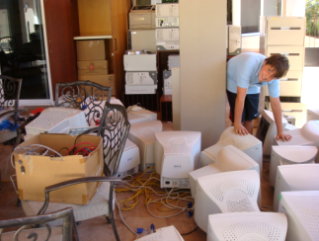 | Computers donated by Western Australian businesses and government departments were checked by students, refurbished and then loaded with suitable software for use by administrative staff in Tanzanian schools. These computers would enable Tanzanian schools to start keeping student records electronically rather than the hand written method which was often on a blackboard. |
| Many hours were spent by ATYA students and their families collecting donated school resources, packing them into boxes and then loading up the large sea container used to transport the goods to Tanzania. In Tanzania, the goods were received by an ATYA representative and all resources were delivered to the project schools. | 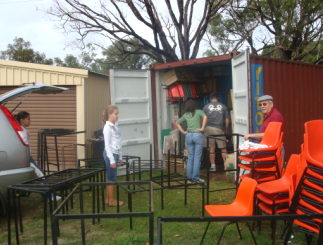 |
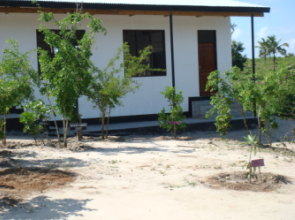 | This is the new classrooms built at Millennia Primary School in collaboration with the local community. The building can be used as a large meeting hall or divided by pull down roller doors to create two classrooms. The building was named Sarah's Hall, after the President of the Australian branch of ATYA. |
The Australian ATYA students were joined each day by on average 30 Tanzanian students and teachers who hosted their visits to all the Tanzanian schools participating in the ATYA program. Trees were planted at each school as a symbol of the growing relationship between Australian and Tanzanian youth.
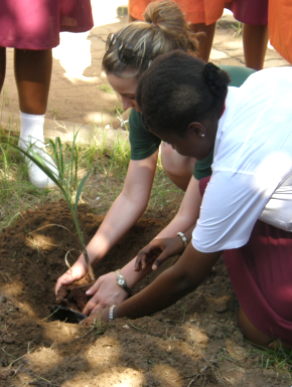 | Here an Australian student is working together with a fellow student from her Sister School to plant a tree in the grounds of a Tanzanian High School. Tree planting was a significant part of the Australian students' visits to eight of the ATYA Tanzania schools. It symbolised the future and a strength in the bond between the youth of Australia and Tanzania. |
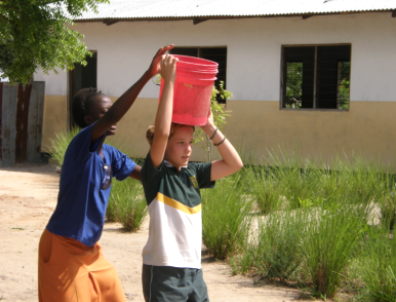 | The Australian students were keen to experience the daily school life of their Tanzanian friends. They carried buckets of water from the new well provided by their service work to flush out the toilet block. In the past this school with over 800 students had no water for drinking or sanitation. |
In a more formal setting, the participating students explored the concept of being a citizen of both a local and global community through Youth Round Table Discussion sessions and Panel Presentations, which were open to all conference attendees. The Round Table sessions were smaller groupings of approximately fourteen students and they were co-facilitated by Australian and Tanzanian teachers. Each country's representatives shared their experiences, thoughts and visions on the conference themes. The conference themes included Good Government and Democracy, Sustainable Environments, Young Ambassadors for Perpetual International Relations, and The Importance of Education. Conference sessions were facilitated by teachers but it was the voice of the Young Ambassadors that was heard.
The Forum had a high profile in Tanzania and was repeatedly reported in the local newspapers and covered on the Tanzanian channel 10 news. The Conference was opened by the Australian High Commissioner to Tanzania, Her Excellency Ms Lisa Filipetto and the Tanzanian Minister for Foreign Affairs the Honourable Bernard Kamilius Membe. Her Excellency Lisa Filipetto in her opening address to the Bilateral Youth Conference related the relationship of Australia and Tanzania as being like the Kangaroo and Giraffe. She explained:
The Kangaroo with its strong tail for balance and legs for jumping can not move backwards. It is like Australia and its consistent movement forward. The Giraffe with its long legs and neck sees into the future. Each animal symbolised a strong partnership between Australia and Tanzania as they moved forward, together into the future.In response the Honourable Bernard Membe, highlighted in his opening address the valuable role Youth could take in building friendship between the two countries. He related finding young people, "fresh and able to think creatively with clear vision and ideas for the future". Together these speakers contributed to building an expectation that the conference would provide a bridge of understanding and friendship between Australia and Tanzania. The aim of the conference was to facilitate students jointly developing strategies for improving inter-cultural understandings and relationships. In addition, it aimed to enable Australian and Tanzanian Youth to jointly identify a range of perspectives, issues and questions in the Forum themes. As an example, the students' conversations and sharing about sustainable environments is described in the following section.
Air
The atmosphere is like lungs to the earth. They are damaged by carbon monoxide which acts like a cancer, destroying the ozone layer. Essential gases are polluted by emissions from cars and factories. We need to cut green house gases. People made the problem so they should fix the problem. People exploit but they should preserve.
Water
It comes from the river, ocean and rain. It is used for domestic purposes and drinking. Water is life. We go to the village centre to collect water. Villagers walk miles and miles to get water. But we pollute land water and this can also pollute the oceans. Even water that is there is not there because of pollution.
Land
Land is described as the dry patch of earth. The vegetation provides shelter and food. We mine minerals. Farm chemicals pollute soil. Holes are dug and used for dumping. Trees are cut down causing deforestation. We cut trees to build up to first world living but we lose oxygen and rain water. We exploit it so it is up to us to change it. Change coal and trees to solar and wind power. Change chemical to natural farming products.
Farming in Tanzania
Farms are mostly owned by the State. Local farms are for subsistence food. Farming is the backbone of Tanzania but people can't always produce enough food for themselves. If more is produced it can be sold. Farming is hard as it uses hoes and hand tools. There is no machinery. Now tropical fruits are grown but they cannot be processed or canned. Produce rots as there is too much to use but we cannot export.
Education for sustainability
Man (humanity) is totally accountable for the future when trying to fulfil his (their) needs today. We have to have a mutual relationship with the environment. We need to live life without being destructive. This requires support for education so people know to help make the change. Education is first.
Farming in Australia
Australia is a very large continent but the centre is very dry and nothing grows there. In Western Australia most farming occurs in the South West due to the milder climate and higher rainfall. The crops grown are wheat (largest export), barley (cereal and food), lupins and canola (food for cattle). Cattle and sheep are farmed. Large farms are run by a small number of people as they use large machinery such as seeders (large areas seeded in a short time), sprayers and harvesters.
Soil degradation
Soil salinity is caused by clearing trees and salt rising to the surface. The crops can no longer grow in salt affected soil. We plant 'Ribbons of Green' which are wide lines of trees planted to help counteract salinity. In some areas floods erode the topsoil with the good nutrients for plant growth. We cut contour banks into these areas to help stop the run off of soil.
Water management
Australia is a dry country but we still use water freely and even wastefully. Our dams are now lower than ever and we have to learn to conserve. We have laws that only allow us to water our gardens 2 days a week which has saved 45 gigalitres per year. Swimming pools have covers to slow evaporation. We are encouraged to take less than 5 minutes for showers. Our washing machines are now made more efficient so they use less water. Our Government is aware and taking steps to make us save water. They have built a new water desalination plant which turns salt water into drinking water.
Green house effect and global warming
Australia is also affected by the greenhouse effect and global warming. It is a natural process in which heat from the sun is trapped near the earth's surface and makes the temperature of the earth rise. It is increasing because of pollution blanketing the Earth, trapping in the heat and causing global warming. Signs of this are melting icecaps, rising sea levels, droughts and we are seeing that coral on the Great Barrier Reef is bleaching. People are talking but not much is happening at the moment. People are talking about cleaner coal, solar power, wind power and perhaps nuclear power.
Renewable energy
Coal is used for producing electricity. Our major power plant is fossil fuel fed. This is unsustainable as we are running out of coal and the power plants cause pollution. The change to solar, wind and hydro power is slowly happening. Nuclear energy is being considered as uranium is readily available in Australia.
Emission trading scheme
The Government has recently created a policy to try and reduce pollution from industry. A company gets credit and can pollute to that amount and not over. Smaller businesses that don't need their allowance can on sell to bigger companies who need more. You can also plant trees as a trade off against pollution from your industry.
Recycling
We have a large advertising campaign Reduce, Reuse, Recycle. We have Green Bins (for household waste which is dumped at tips) and Yellow Bins (for recyclable cans, bottles etc which go to recycling depots). For example aluminium cans are compacted, made into aluminium pellets and reused to make other aluminium items. Dumping rubbish will get you an on the spot fine.
Imagine the active listening required and the effort given by students to explain their diverse lives and experiences. Interestingly, the conversations didn't stop at the close of the session. A group of students continued to talk intently over lunch.
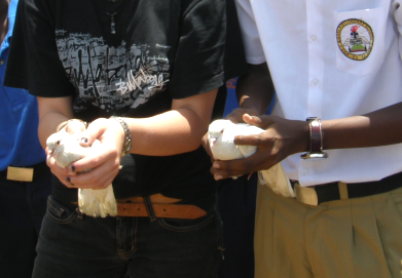 | The releasing of two white doves carrying the Australian and Tanzanian flags symbolized the friendship bond between the two countries. This was an emotional experience for all the participants which brought to a close the first ATYA tour to Tanzania. |
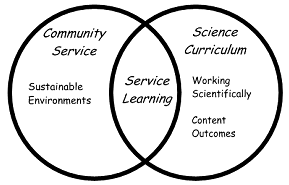
Figure 1: Linking community service with the science curriculum
To illustrate, engaging students with key principles of sustainable environments required the integration of science concepts. Students were provided with the opportunity and at times the demand to use their science understandings as a tool to make sense of their local and global communities. The ATYA students had to draw on and develop their scientific literacy. Scientific literacy was viewed as multidimensional and a composite, in some way, of science concepts and ideas, the nature of science and the interaction of science and society (Bybee 1997, Hurd 1997, Laugksch 2000, Murcia, 2009, Soloman 2001, Tytler, 2007). Students were developing scientific literacy as they applied science to daily life. They used science for making sense of the world, for problem solving and developing informed opinions. This included critiquing science's effect on social and natural environments in both Australia and Tanzania (Kolsto, 2001). Interwoven with students' thinking about the environment and the diverse social contexts was an understanding of key science concepts and inquiry methods. The learning experiences provided while preparing, participating and then reflecting on the Forum theme of sustainable environments created opportunities for integrating knowledge from all dimensions of scientific literacy; interaction of science with society, nature of science and key science concepts. The potential interaction of these science knowledge dimensions in a service learning context is illustrated in Figure 2.
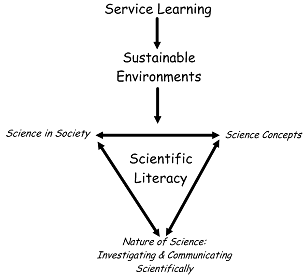
Figure 2: Learning and teaching for scientific literacy within service learning
The learning and teaching experiences supporting the development of scientific literacy were holistic in nature and driven by the socially relevant issue of sustainability. Students were encouraged to draw on science concepts, as required for understanding the Australian and Tanzanian perspectives on sustainable environments. Time was given to eliciting students' prior knowledge, small group shared exploration of concepts and 'jig-sawed' research on selected aspects of the topic. Each student then contributed an area of expertise to the whole groups' understanding of sustainable environments. Students engaged meaningfully with the topic and practised sharing their ideas with the whole Australian delegation before attending the ATYA tour and Bilateral Youth Forum.
Responding to the students' shared concerns which emerged during the Bilateral Youth Forum would require an increasing number of citizens to be better informed about sustainability issues. Understanding the intersection of science with society and its role in the transition to sustainability would encourage more citizens to take actions such as consuming less energy, recycling and practising sustainable land management. Education was recognised as a key contributor to achieving sustainability in the proceedings from an Australian Academy of Science conference, Science at the Dome. It was stated by Pearman, Scaife and Walker, (2002) in their presentation titled A blueprint: the science needed to underpin Australia's transition to sustainability that educational reforms for the transition to sustainability should include appropriate modules in school science curricula to educate students on the 'state of the world' and the role of science in the transition to sustainability and that we should be aiming for a science and technology literate and critical society. An effective and relevant science education was presented as an essential element of all aspects of the transition to sustainability. Scientific literacy at the citizen's level was seen to be essential for developing sustainable practices and protecting and conserving irreplaceable global resources.
The educational reforms articulated by Pearman et al. (2002) would be supported by linking community service projects such as the described ATYA case study with its focus on sustainable environments, to the science curriculum. The international context gave students first hand experience of what Pearman et al. (2002) referred to as the 'state of the world' and generated the need to critique science's role in the transition to sustainability. This included reflection on science's aims and limitations at the intersection with society. Social constructivist learning theory informed the approach taken and the programs developed for the Bilateral Youth Forum. There was an emphasis on co-operative group work, sharing of ideas and communication skills. The tasks were student centred and encouraged interactive construction of shared knowledge and understanding. The students were actively involved and responsible for their learning. The scaffolding of the learning experience encouraged students to learn about sustainable environments but also modelled an approach to learning how to learn. The learning was essentially driven by a desire to understand and to solve a problem. Students learned science content and theory in order to develop a global perspective on the issue of sustainable environments. The constructivist model structured the sequencing of activities and informed each stages instructional purpose (Bybee, Taylor, Gardner, Van Scotter, Powell, Westbrook and Landes, 2006). In Table 1, the ATYA case study is used to articulate the constructivist learning model and illustrate the opportunities for developing students' scientific literacy. This model is recommended to educators interested in facilitating effective service learning experiences for students, working on either local or international community projects.
| Phase | Instructional purpose | Example activities: Sustainable environments (ATYA) | Developing scientific literacy: Opportunities and demands |
| Engage | -Motivate students to engage with the context, situation or problem. -Promote curiosity and make connections with past and present learning experiences. -Elicit students' prior conceptions. |
-Interaction with a representative of the Tanzanian Government and engagement with first hand experience stories of the country. -Discussion of the political, social, economic and environmental dimensions of life in Tanzania as presented in visual images. -Participation in small group brainstorming and concept mapping on sustainable environments. -Selection of a sub-topic of personal interest. e.g. global warming, water management, soil degradation and land usage |
-Reflecting on the context and identifying relevant questions to ask and science topics to research. -Identifying science's role in understanding sustainable environments. |
| Explore | -Provide a common base of activities. -Encourage students to use their prior knowledge and generate new ideas. -Explore questions and possibilities. |
-Inquiry based research into a selected sub-topic. E.g. literature search and accessing online resources. -Written summary of ideas and collection of illustrative images to support group presentation and communication. |
-Demonstrating the confidence to use science as a tool to assist in making sense of sustainable environments. -Practising the process of scientific inquiry. -Finding out the views and ideas of 'experts' in science |
| Explain | -Student explanation of their understanding of the topic. -Further teacher explanation to guide students toward a deeper understanding. |
-Small group sharing of individual students' research. -Using a jig-saw approach to support collaboration and enable students to contribute a piece of expertise to the bigger picture theme. -Group facilitator's clarification and explanation of science concepts underlying the sustainable environment theme. -Small group presentation to the whole tour group and responding to questions. |
-Communicating scientifically -Providing evidence to support points of view -Demonstrating active listening skills -Critically evaluating what is said and the science concepts presented. |
| Elaborate | -Presentation of a new experience or context. -Challenge and extend students' conceptual understanding and skills. -Students apply their understanding of the concept by conducting additional activities. |
-Collaborative presentation and discussion of ideas and issues by Tanzanian and Australian students at the Bilateral Youth Forum. -Asking clarify questions, challenging assumptions and seeking to understand from another cultural perspective. -Responding to questions from all participants at the Forum during the Panel Presentation. |
-Applying scientific understandings to a new and different context. -Critically engaging with science's role in the transition to sustainable environments. -Openness to ideas that challenge initial concepts and attitudes. -Deepening and extending understanding of science concepts in relation to sustainable environments. |
| Evaluate | -Structured reflection activities. -Encourage students to assess their understanding and abilities. -Teachers to evaluate student progress. |
-Reflecting through daily journal writing. -Talking and sharing experiences with others. -Participating in a semi-structured interview to facilitate reflection. |
-Communicating the interrelated and connected nature of science concepts, processes and values to social issues. -Articulating science's impact on them personally, the broader community and the global community. |
The ATYA Bilateral Youth Forum resulted in the identification of similarities and differences between social, educational and environmental issues in Tanzania and Australia. Intercultural activities and experiences provided opportunities for the young ambassadors to develop a deeper understanding of themselves and what it could mean to be a citizen of the world. Their planning and conducting of themed round table discussion groups highlighted the need for personal skills in resourcefulness, adaptability, inter-cultural communication and self-management. In particular, engaging with the theme sustainable environments highlighted the need to connect with the science curriculum and generated the richer option of service learning. Conceptualising the ATYA program and the Bilateral Youth Forum as service learning provided a range of opportunities and demands for students to use and further develop understandings from the core curriculum. Principles of social constructivist learning theory framed the design and facilitation of the service learning experiences. The ATYA case study was used in this paper to articulate the constructivist learning model and make explicit the opportunities for encouraging students' development of scientific literacy within community service projects.
Importantly, through community service and learning strong foundations have been laid for a lasting bond of friendship between Australian and Tanzanian people. This is evident in the following words of a Tanzanian teacher and a natural moment between friends captured in the photo below.
When they came together, they found the Australian boys and girls to be very friendly, but in the beginning they feared them. When they came together they realised they are just people who can mix and discuss and share issues. The Australian students have attracted our students by asking different questions, sharing what they are thinking about, sharing their dreams. This among other things is good. The Africans, in a positive way have accepted their friends.
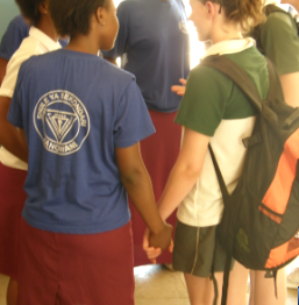
The benefits of the community service and service learning programs undertaken by ATYA were concrete and observable when you consider the donated educational resources. The additional classrooms, water wells, books and school resources have made an indelible impression on the education and development of thousands of young people. The benefits of the Bilateral Youth Forum were more abstract, but still tangible when listening and watching the participating students. These diverse groups of students jointly develop strategies to improve inter-cultural understandings and relationships. They developed a greater awareness and understanding of global issues and were discussing these with open and honest dialogue. Another indicator of the success of the ATYA tour to Tanzania and Bilateral Youth Forum is in the future actions of participating schools. A group of Australian schools have plans for sustaining the ATYA program through bi-annual tours to Tanzania. In 2010, four schools are concluding another two year community service cycle with a tour to Tanzania. Again, these Australian young ambassadors have contributed to raising community awareness and the funds necessary for providing essential education resources to their sister schools in Tanzania.
It is hoped that through sharing the ATYA case study and the resulting service learning model that other educators will see possibilities around them for engaging students in meaningful community service programs. As one teacher remarked, "We can all make a difference to the world by acting within our realm of influence."
Arenas, A., Bosworth, K., Kwandayi, H. (2006). Civic service through schools: An international perspective. Compare: A Journal of Comparative Education, 36(1), 23-40.
Bybee, R. (1997). Achieving scientific literacy: From purposes to practices. Portsmouth: Heinemann.
Bybee, R., Taylor, J., Gardner, A., Van Scotter, P., Powell, J., Westbrook, A., & Landes, N. (2006). The BSCS 5E Instructional Model: Origins, Effectiveness and Applications. At http://www.bscs.org/. Accessed 15/6/09
Curriculum Council. (1998). Curriculum Framework. Curriculum Council of Western Australia.
Curriculum Council, (2010). Community Service Guidelines. (accessed 15/6/09) At http://www.curriculum.wa.edu.au/internet/_Documents/General/Community+Service+Guidelines+PDF.pdf
Hurd, P. (1997). Scientific literacy: New minds for a changing world. Science Education, 82, 407-416.
Kolsto, S. (2001). Scientific literacy for citizenship: tools for dealing with the science dimension of controversial socioscientific issues. Science Education, 85, 291-310.
Larkin, R. & Mahoney, A. 2006. Empowering youth to change their world: Identifying key components of a community service program to promote positive development. Journal of Social Psychology, 44, 513-531.
Laugksch, R. (2000). Scientific literacy: a conceptual overview. Science Education, 84, 71-94
Murcia, K. (2008). Scientific literacy for sustainability: Educating citizens for the 21st century. VDM Verlag. Germany.
Murcia, K. (2009). Re-thinking the development of scientific literacy through a rope metaphor. Research in Science Education, 39(2), 215-229.
Patton, M. (2002). Qualitative research and evaluation methods. Sage Publications. United Kingdom.
Pearman, G., Scaife, P., & Walker, B. (2002). A blueprint: The science needed to underpin Australia's transition to sustainability. Paper presented at the Australian Academy of Science annual symposium: Transition to Sustainability. At http://www.science.org.au/events/sats/sats2002/blueprint.html. Accessed 15/6/09
Shumer, R. (2005). Service-learning research: What we have learned from the past. Growing to Greatness 2005. At http://www.utm.edu/tncc/files/Robert_Schumer_Service_Learning_Research_What_Have_We_Learned_from_the_Past[1].pdf. Accessed 20/1/09.
Solomon, J. (2001). Teaching for scientific literacy: what could it mean? School Science Review, 82, 93-96.
Tytler, R. (2007). Re-imagining Science Education: Engaging students in science for Australia's future. Australian Education Review, No.51. Australian Council for Education Research, ACER Press.
United Nations (1992). Report of the United Nations Conference on Environment and Development. Rio de Janeiro. At http://www.un.org/esa/dsd/agenda21/. Accessed 15/6/09
World's Scientific Academies. (2000). Transition to sustainability in the 21st century: The contribution of science and technology. Conference of the Inter-Academies Panel, Tokyo. At http://www.interacademies.net/?id=3568 Accessed 15/6/09
| Authors: Dr Karen Murcia has researched in scientific literacy, numeracy and interactive pedagogy and is currently lecturing in science education and research methods at Edith Cowan University. She has extensive school based action research experience in which she works collaboratively with teachers to enhance student learning. Email: k.murcia@ecu.edu.au
Dr Yvonne Haigh has a background in political theory and her research interest is analysing relationship between theory and practice in the everyday world. Yvonne lecturers in the Politics and Community Development programs at Murdoch University, and takes a range of social research projects in the Centre for Social and Community Research. Email: y.haigh@murdoch.edu.au Dr Lindy Norris works in the areas of second language research, teachers' professional development, curriculum design, and program evaluation. Her research has encompassed many dimensions of languages education in the Australian context. She is working on a number of projects associated with second language socialization and the development of intercultural competence. Email: l.norris@murdoch.edu.au Please cite as: Murcia, K., Haigh, Y. & Norris, L. (2010). Learning from community service: Engaging Australia Tanzania Young Ambassadors with sustainability Issues In Educational Research, 20(3), 294-313. http://www.iier.org.au/iier20/murcia.html |